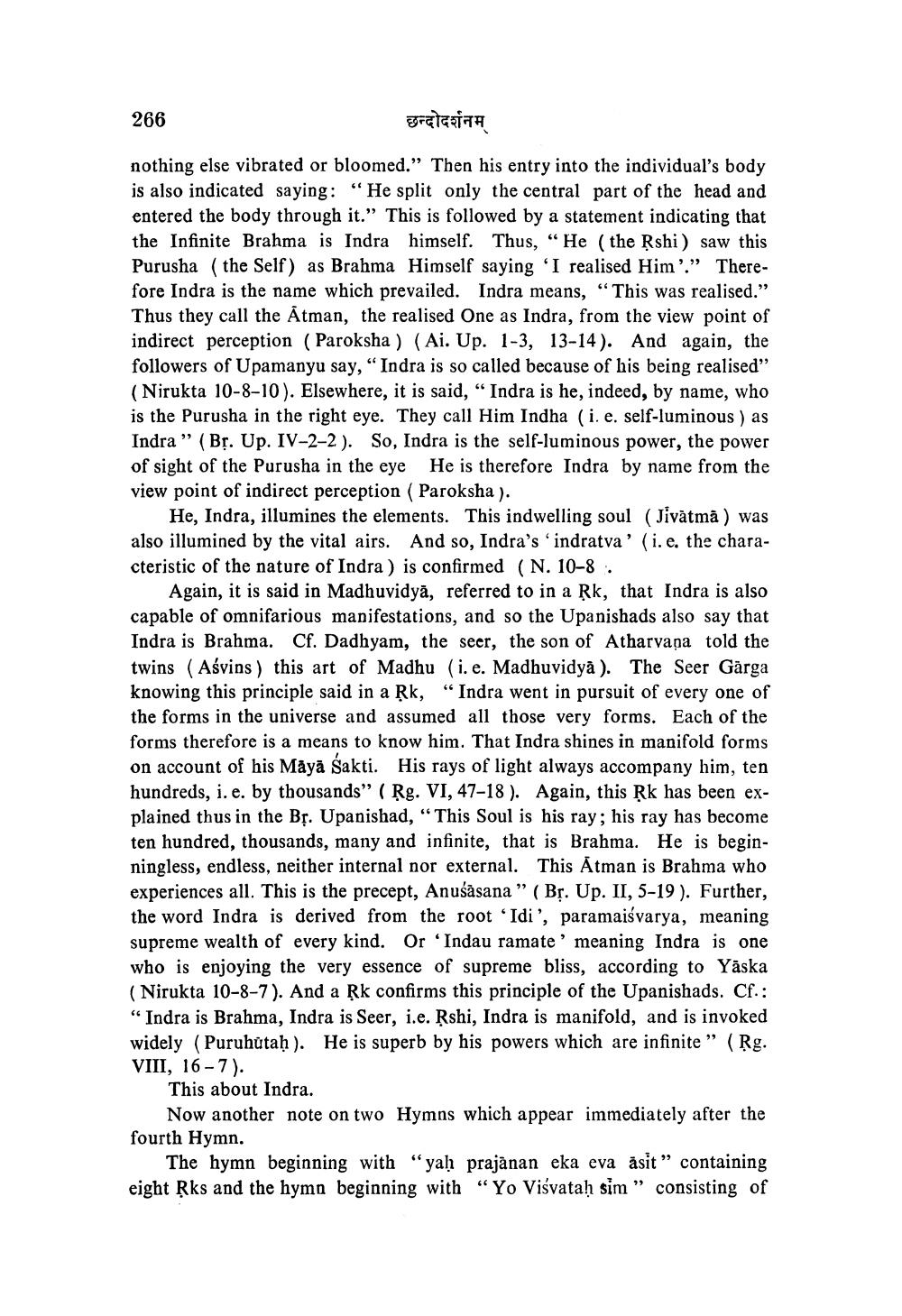________________
266
छन्दोदर्शनम
nothing else vibrated or bloomed." Then his entry into the individual's body is also indicated saying: "He split only the central part of the head and entered the body through it.” This is followed by a statement indicating that the Infinite Brahma is Indra himself. Thus, “He (the Rshi) saw this Purusha (the Self) as Brahma Himself saying 'I realised Him'." Therefore Indra is the name which prevailed. Indra means, “This was realised." Thus they call the Atman, the realised One as Indra, from the view point of indirect perception (Paroksha ) (Ai. Up. 1-3, 13-14). And again, the followers of Upamanyu say, “Indra is so called because of his being realised" (Nirukta 10-8-10). Elsewhere, it is said, " Indra is he, indeed, by name, who is the Purusha in the right eye. They call Him Indha (i. e. self-luminous ) as Indra” (Br. Up. IV-2-2). So, Indra is the self-luminous power, the power of sight of the Purusha in the eye He is therefore Indra by name from the view point of indirect perception (Paroksha).
He, Indra, illumines the elements. This indwelling soul (Jivātmā) was also illumined by the vital airs. And so, Indra's 'indratva' (i.e. the characteristic of the nature of Indra ) is confirmed (N. 10-8
Again, it is said in Madhuvidyā, referred to in a Rk, that Indra is also capable of omnifarious manifestations, and so the Upanishads also say that Indra is Brahma. Cf. Dadhyam, the seer, the son of Atharvana told the twins (Asvins) this art of Madhu (i.e. Madhuvidyā). The Seer Gärga knowing this principle said in a Řk, “Indra went in pursuit of every one of the forms in the universe and assumed all those very forms. Each of the forms therefore is a means to know him. That Indra shines in manifold forms on account of his Māyā Sakti. His rays of light always accompany him, ten hundreds, i.e. by thousands" (Rg. VI, 47-18). Again, this Rk has been explained thus in the Br. Upanishad, “This Soul is his ray; his ray has become ten hundred, thousands, many and infinite, that is Brahma. He is beginningless, endless, neither internal nor external. This Ātman is Brahma who experiences all. This is the precept, Anusāsana” (Br. Up. II, 5-19). Further, the word Indra is derived from the root 'Idi', paramaiśvarya, meaning supreme wealth of every kind. Or 'Indau ramate' meaning Indra is one who is enjoying the very essence of supreme bliss, according to Yaska (Nirukta 10-8-7). And a Rk confirms this principle of the Upanishads. Cf.: “Indra is Brahma, Indra is Seer, i.e. Rshi, Indra is manifold, and is invoked widely (Puruhůtaḥ). He is superb by his powers which are infinite” (Rg. VIII, 16-7).
This about Indra.
Now another note on two Hymns which appear immediately after the fourth Hymn.
The hymn beginning with "yah prajānan eka eva asit” containing eight Ķks and the hymn beginning with “Yo Viśvataḥ sim " consisting of




